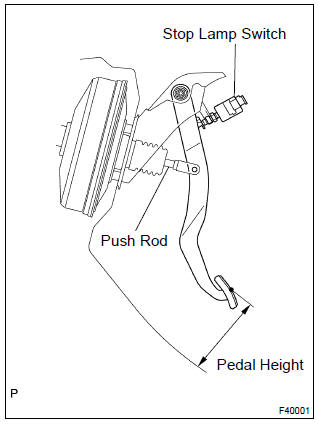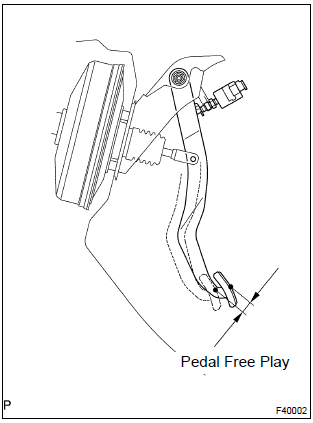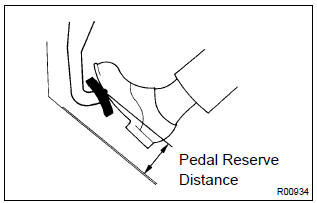Toyota Corolla (E120): Adjustment
1. Check and adjust brake pedal height

- Inspect brake pedal height.
Pedal height from asphalt sheet: m/t: 134.9 – 144.9 Mm (5.311 – 5.703 In.) A/t: 136.0 – 146.0 Mm (5.353 – 5.747 In.)
- Disconnect the connector from the stop lamp switch.
- Remove the stop lamp switch.
- Loosen the clevis lock nut.
- Adjust the pedal height by turning the pedal push rod.
- Tighten the push rod lock nut.
Torque: 26 nvm (265 Kgf·cm, 19 ft·lbf)
- install the stop lamp switch.
- Connect the connector to the stop lamp switch.
- Push the brake pedal in 5 – 15 mm (0.20 – 0.59 In.), And turn the stop lamp switch to lock the nut in the position where the stop lamp goes off.
- After installation, push the brake pedal in 5 – 15 mm (0.20 – 0.59 In.), Check that stop lamp comes on.
2. Check pedal free play

- Stop the engine and depress the brake pedal several times until there is no more vacuum left in the booster.
- push in the pedal until the beginning of the resistance is
felt. Measure the distance, as shown in the installation.
Pedal free play: 1 – 6 mm (0.04 – 0.24 In.)
If incorrect, check the stop lamp switch clearance.
If the clearance is ok, then troubleshoot the brake system.
Stop lamp switch clearance: 0.5 – 2.4 Mm (0.020 – 0.094 In.)
3. Check pedal reserve distance

- Release the parking brake lever.
With engine running, depress the pedal and measure the pedal reserve distance, as shown in the installation.
Pedal reserve distance from asphalt sheet at 490 n (50 kgf, 110.2 Lbf): more than 70 mm (2.76 In.)
If incorrect, troubleshoot the brake system.
Other materials:
Dialing
1 Display the phone screen. 2 Select the “Dial Pad” tab and enter a phone number.
To delete the input phone number, select
.
For the first digit, you can enter “+” by selecting “*” for a while.
3 Press the switch on the steering
wheel or select . ...
Maintenance requirements
To ensure safe and economical driving, day-to-day care and regular maintenance
are essential. It is the owner’s responsibility to perform regular checks. Toyota
recommends the following maintenance:
General maintenance
General maintenance should be performed on a daily basis. This can be don ...
Safety information for
Safety Connect
Important! Read this information
before using Safety Connect.
■ Exposure to radio frequency
signals
The Safety Connect system
installed in your vehicle is a
low-power radio transmitter and
receiver. It receives and also
sends out radio frequency (RF)
signals.
In August 1996, the Federal
Communica ...


